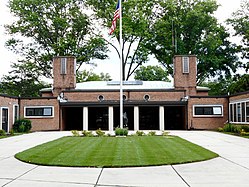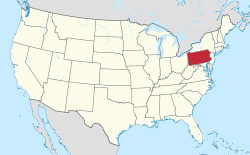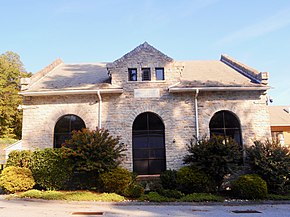Springfield Township, Delaware County, Pennsylvania
Springfield Township, Delaware County, Pennsylvania | |
|---|---|
 Municipal Building | |
 | |
 Location of Pennsylvania in the United States | |
| Coordinates: 39°56′00″N 75°19′59″W / 39.93333°N 75.33306°WCoordinates: 39°56′00″N 75°19′59″W / 39.93333°N 75.33306°W | |
| Country | United States |
| State | Pennsylvania |
| County | Delaware |
| Founded | 1686 |
| Area | |
| • Total | 6.34 sq mi (16.42 km2) |
| • Land | 6.32 sq mi (16.37 km2) |
| • Water | 0.02 sq mi (0.05 km2) |
| Elevation | 243 ft (74 m) |
| Population (2010) | |
| • Total | 24,211 |
| • Estimate (2016)[2] | 24,342 |
| • Density | 3,850.97/sq mi (1,486.98/km2) |
| Time zone | UTC-5 (EST) |
| • Summer (DST) | UTC-4 (EDT) |
| ZIP code | 19064 |
| Area code(s) | 610 and 484 |
| FIPS code | 42-045-73032 |
| FIPS code | 42-045-73032 |
| GNIS feature ID | 1216391 |
| Website | www |
Springfield Township, or simply Springfield, is a township in Delaware County in the U.S. state of Pennsylvania. The population was 24,211 at the 2010 census.[3] Springfield is a suburb of Philadelphia, located about 10 miles (16 km) west of the city.
Geography[]
Springfield is located in eastern Delaware County at 39°55′37″N 75°20′7″W / 39.92694°N 75.33528°W (39.926961, -75.335231).[4] According to the United States Census Bureau, the township has a total area of 6.34 square miles (16.42 km2), of which 6.32 square miles (16.37 km2) is land and 0.02 square miles (0.05 km2), or 0.28%, is water.[3] The northeastern border of the township is formed by Darby Creek, and the western border is formed by Crum Creek, both of which flow south to the Delaware River.
Adjacent municipalities[]
- Haverford Township, Delaware County - north
- Upper Darby Township, Delaware County - east
- Ridley Township, Delaware County - south
- Morton Borough, Delaware County - south
- Swarthmore Borough, Delaware County - southwest. (A small exclave of Springfield Township is located south of Swarthmore Boro (see map to right)).
- Nether Providence Township, Delaware County - southwest
- Marple Township, Delaware County - northwest
Climate[]
Springfield has a humid subtropical climate (Cfa) and the hardiness zone is 7a. Average monthly temperatures in the vicinity of the library range from 32.6 °F (0.3 °C) in January to 77.7 °F (25.4 °C) in July.[5]
Demographics[]
| Historical population | |||
|---|---|---|---|
| Census | Pop. | %± | |
| 1930 | 4,589 | — | |
| 1940 | 5,488 | 19.6% | |
| 1950 | 10,917 | 98.9% | |
| 1960 | 26,733 | 144.9% | |
| 1970 | 29,006 | 8.5% | |
| 1980 | 25,326 | −12.7% | |
| 1990 | 24,160 | −4.6% | |
| 2000 | 23,677 | −2.0% | |
| 2010 | 24,211 | 2.3% | |
| 2016 (est.) | 24,342 | [2] | 0.5% |
| U.S. Decennial Census[6] | |||
As of Census 2010, the racial makeup of the township was 93.4% White, 1.7% African American, 0.1% Native American, 3.8% Asian, 0.2% from other races, and 0.8% from two or more races. Hispanic or Latino of any race were 1.1% of the population [1].
As of the census[7] of 2000, there were 23,677 people, 8,618 households, and 6,790 families residing in the township. The population density was 3,723.0 people per square mile (1,437.4/km2). There were 8,800 housing units at an average density of 1,383.7/sq mi (534.2/km2). The racial makeup of the township was 94.6% White, 0.5% African American, 0.05% Native American, 4.2% Asian, 0.01% Pacific Islander, 0.12% from other races, and 0.54% from two or more races. Hispanic or Latino of any race were 1.65% of the population.
There were 8,618 households, out of which 32.7% had children under the age of 18 living with them, 67.3% were married couples living together, 8.6% had a female householder with no husband present, and 21.2% were non-families. 19.3% of all households were made up of individuals, and 11.9% had someone living alone who was 65 years of age or older. The average household size was 2.73 and the average family size was 3.14.
In the township the population was spread out, with 24.0% under the age of 18, 6.2% from 18 to 24, 25.0% from 25 to 44, 24.5% from 45 to 64, and 20.3% who were 65 years of age or older. The median age was 42 years. For every 100 females there were 91.8 males. For every 100 females age 18 and over, there were 88.4 males.
The median income for a household in the township was $89,019, and the median income for a family was $103,424.[8] Males had a median income of $64,830 versus $50,651 for females.[8] The per capita income for the township was $35,231. About 1.7% of families and 3.4% of the population were below the poverty line, including 5.3% of those under age 18 and 6.7% of those age 65 or over.
Education[]

Pupils in Springfield Township attend schools in the Springfield School District. This is not to be confused with the Springfield Township School District, which is located in Springfield Township, Montgomery County, Pennsylvania.
Public Schools:
- Springfield Literacy Center - all kindergarten and first grade students in the school district
- Scenic Hills School - students in grades 2 through 5 - enrollment based on geographic proximity
- Harvey C. Sabold School - students in grades 2 through 5 - enrollment based on geographic proximity
- E. T. Richardson Middle School - all students in grades 6, 7, and 8 in the school district (approximately 1,000 students)
- Springfield High School - all students in grades 9 through 12 in the school district (approximately 1,200 students)
- As of August 2018,[9] a new high school is under construction and is planned to be finished by 2021.
Families in Springfield Township could choose to send their children to Swarthmore High, , and/or prior to the 1931 establishment of Springfield High School.[10]
Private / Parochial schools:
- Holy Cross - Catholic grade school - students in grades K-8
- St. Francis of Assisi - Catholic grade school - students in grades K-8
- Cardinal O'Hara High School - students in grades 9-12
St. Kevin School, another Catholic grade school, operated from 1967[citation needed] until 2011. The archdiocese closed it due to declining enrollment despite advocacy from community members to keep it open. It had 158 students in spring 2011, with parents stating that the number scheduled to attend in the fall of that year was over 130 while the archdiocese stated that number was 93.[11] It was one of three Catholic schools in Delaware County to close at that time.[12]
History[]
First settled by Quakers who arrived in Pennsylvania with William Penn, Springfield was first recognized as a governmental entity in 1686.[13] Many of the streets in Springfield are named after former prominent citizens, including Powell, Kennerly, Lownes, Levis, Maris, Thomas, Beatty, Lewis, Foulke, Evans, Powell, Pancoast, Worrell, and Edge. Originally, Springfield was primarily a farming town.
On December 9, 1687, the settlers began laying the road to Amosland as it was then called. This road is now known as Springfield Road. In 1701 construction began on the Baltimore Pike; the road was formed of sturdy oak planks, some of which still exist under the current Baltimore Pike. 1701 also marked the year that construction began on the first Quaker meeting house. The meeting house burned in 1737 and was rebuilt. The current meeting house that stands in its spot was constructed in 1851.
By the date of the signing of the Declaration of Independence in 1776 it is estimated from tax records that about 300 people resided in Springfield.
By the 19th century Springfield had become more industrialized. Taking advantage of its many creeks for power, the inhabitants erected many mills. Well-known mill owners included William Fell, Samuel Pancoast, William Beatty, Samuel Levis, and Moses and Emanuel Hey.
At the beginning of the 20th century Springfield's Baltimore Pike had become one of the busiest commercial areas outside of Philadelphia. The long, straight stretch of Baltimore Pike in the township was referred to as "The Golden Mile", commonly known for its many automobile dealerships. Baltimore Pike remains true to its history with many dealerships lining the side of the road. The Golden Mile is a unique corridor that is essentially a compact commercial strip that cuts directly through bedroom communities on both sides. Residents are currently attempting to undo the emblematic effects of urban sprawl along the mile through the implementation of green initiatives, responsible traffic planning, and zoning improvements.
In the past century, all of Springfield's farmland was slowly bought up by developers who turned Springfield into the town it is today, that is, largely comprising developments of standard suburban single-family homes. One of the largest single developments was the Stoney Creek development. Construction began in 1949 and was completed in only five years. The huge development stretched from West Avenue to Providence Road and ran all the way up to Baltimore Pike. Over 75 homes were constructed in the development. Similar to most housing developments of their time, no two houses in Stoney Creek were built exactly the same. While all resemble each other with their stone fronts and common size, additional luxuries such as porches and window placement were available for purchase to make each one slightly unique.
Though all of the farmland of Springfield's past is gone, many of the woods and fields of the past still remain standing today in some of the many parks located throughout the community.
The bulk of Springfield's history lies recorded in the archives of the Heritage Society of Springfield, and the Springfield Township Public Library (a member of the Delaware County Library System).
Springfield has three sister cities, Lisbon, Portugal, Lima, Peru, and Vancouver, Canada.[citation needed]
Economy[]
The township is home to Springfield Mall, a 590,000-square-foot (55,000 m2), two-level shopping mall. One of the first of several suburban locations of Strawbridge & Clothier was located in Springfield. The old Strawbridge & Clothier has since been reconstructed into a Target.
Religion[]
Catholic churches in Springfield Township include Holy Cross Church, St. Francis of Assisi Church, and St. Kevin Church. In 2014 the archdiocese asked the churches to produce documents about their future viability as other Delaware County Catholic churches had closed permanently around that time period.[14] In 2015 the archdiocese stated that, at the time, all three would continue to operate.[15]
People[]
- Mark Alburger, Composer
- Bill Carpenter, West Point "Lonesome End", U.S. Army lieutenant general, recipient of Distinguished Service Cross
- Pat Croce entrepreneur, sports team executive and owner [16]
- J. Edgar Thomson, third president of the Pennsylvania Railroad[17]
- Joey DeFrancesco, jazz organist
- Robert W. Edgar, U.S. Congressman
- Robert Hazard, rock musician
- Tom Keifer, rock musician in the band Cinderella
- Al Martino, singer, film actor
- Geoff Petrie, NBA Rookie of the Year, 1971
- John Pinette, Actor and comedian
- Skip Roderick, former pro soccer player, current men's soccer coach at Elizabethtown College
- Mike Scioscia, MLB catcher LA Dodgers and World Series winning manager LA Angels
- Joe Sestak, Three Star (Vice) Admiral (retired 2005) and U.S. Congressman
- Benjamin West, painter
- Lawrence G. Williams, U.S. Congressman
Notable buildings[]


- Central School (demolished)
- First Presbyterian Church
- Holy Cross Church
- The Old Central School House
- Springfield Library
- Springfield Water Pump House (1899)
- Springfield Mall
- The Springfield Literacy Center (2011)
- Springfield Friends Meeting House
- St. Francis of Assisi Church
- Blue Church
Notable parks[]
There are 24 parks located in Springfield Township, some of the more notable parks are listed below.[19]
- Veterans Memorial Park
- Williams Park (former Powell Road Park)
- Jane Lownes Park
- Indian Rock Park
- Meadowgreen Park
- Halderman Field
- Netherwood Park
- Walsh Park
- Rolling Green Park
- Crowell Park
- Elson Glen Park
References[]
- ^ "2016 U.S. Gazetteer Files". United States Census Bureau. Retrieved Aug 13, 2017.
- ^ Jump up to: a b "Population and Housing Unit Estimates". Retrieved June 9, 2017.
- ^ Jump up to: a b "Geographic Identifiers: 2010 Demographic Profile Data (G001): Springfield township, Delaware County, Pennsylvania". U.S. Census Bureau, American Factfinder. Archived from the original on February 13, 2020. Retrieved December 30, 2015.
- ^ "US Gazetteer files: 2010, 2000, and 1990". United States Census Bureau. 2011-02-12. Retrieved 2011-04-23.
- ^ http://prism.oregonstate.edu/explorer
- ^ "Census of Population and Housing". Census.gov. Retrieved June 4, 2016.
- ^ "U.S. Census website". United States Census Bureau. Retrieved 2008-01-31.
- ^ Jump up to: a b United States Census
- ^ "Springfield High School Master Plan - Springfield School District". www.ssdcougars.org. Retrieved 2018-10-06.
- ^ Springfield Historical Society (2004-06-23). Springfield Township, Delaware County. Arcadia Publishing. p. PT141. ISBN 9781439629017.
- ^ "Archdiocese stands firm on closing St. Kevin School in Springfield". Philadelphia Inquirer. 2011-06-23. Retrieved 2020-05-03.
- ^ Bayliss, Kelly (2011-06-10). "3rd Delco Catholic School to Close". NBC Philadelphia. Retrieved 2020-05-03.
- ^ Ashmeade, Henry Graham (1884). History of Delaware County, Pennsylvania. Philadelphia: L.H. Everts & Co. p. 713. Retrieved 17 June 2017.
- ^ Mengers, Patti (2014-10-13). "Fate of three parishes in Springfield to be determined". Delco Times. Retrieved 2020-05-03.
- ^ Mengers, Patti (2015-05-03). "Springfield's Catholic churches get reprieve — for now". Delco Times. Retrieved 2020-05-03.
- ^ Croce, Pat; Lyon, Bill (2000). I Feel Great and You Will Too!:An Inspiring Journey of Success with Practical Tips on How to Score Big in Life. Running Press.
- ^ https://explorepahistory.com/hmarker.php?markerId=1-A-12D
- ^ Morfe, Don (March 10, 2015). "Springfield Friends Meeting". www.hmdb.org. Retrieved Feb 26, 2016.
- ^ "www.springfielddelco.org". Retrieved February 18, 2016.
External links[]
| Wikimedia Commons has media related to Springfield Township, Delaware County, Pennsylvania. |
- Springfield Township, Delaware County, Pennsylvania
- Census-designated places in Delaware County, Pennsylvania
- Townships in Delaware County, Pennsylvania


